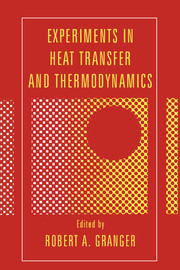Book contents
- Frontmatter
- Contents
- Preface
- Introduction
- Part I Experiments in heat transfer
- I.1 Conduction
- I.2 Convection
- I.3 Boiling
- I.4 Mixing, dispersion, and diffusion
- Experiment 21 Determination of the binary diffusion coefficient in a liquid mixture
- Experiment 22 Diffusion distillation: A separation method for azeotropic mixtures
- I.5 Radiation
- I.6 Heat pipes and exchangers
- Part II Experiments in thermodynamics
- Appendix 1 Experiments and demonstrations in thermodynamics
- Appendix 2 Experiments and demonstrations in heat transfer
- Appendix 3 Heat-transfer and thermodynamic films
- Index
Experiment 21 - Determination of the binary diffusion coefficient in a liquid mixture
Published online by Cambridge University Press: 05 June 2012
- Frontmatter
- Contents
- Preface
- Introduction
- Part I Experiments in heat transfer
- I.1 Conduction
- I.2 Convection
- I.3 Boiling
- I.4 Mixing, dispersion, and diffusion
- Experiment 21 Determination of the binary diffusion coefficient in a liquid mixture
- Experiment 22 Diffusion distillation: A separation method for azeotropic mixtures
- I.5 Radiation
- I.6 Heat pipes and exchangers
- Part II Experiments in thermodynamics
- Appendix 1 Experiments and demonstrations in thermodynamics
- Appendix 2 Experiments and demonstrations in heat transfer
- Appendix 3 Heat-transfer and thermodynamic films
- Index
Summary
Principle
The velocity profile in the laminar flow of a fluid through a cylindrical tube is employed to disperse an injected solute. The radial diffusion of the solute in the tube, arising from the radial concentration gradients so created, opposes this dispersion. The combined effect is to produce a solute distribution in the longitudinal direction within the tube that is Gaussian and whose second central moment is related to the mutual diffusion coefficient of the fluid system.
Object
The object of the experiment is the measurement of the mutual diffusion coefficient of a binary liquid mixture. The experiment illustrates how an understanding of fluid mechanics and transport processes can be employed to develop a powerful and simple measurement technique. The aim of the present simple experiment to be described is to determine the diffusion coefficient of the system n-hexane/n-heptane for almost pure n-heptane at 25 °C.
Background
The process of diffusion is the name applied to the relative motion of molecular species in a fluid mixture under the influence of a gradient of concentration, or more completely, of chemical potential. The simplest possible realization of the process is illustrated in Fig. 21.1, where at time t = 0 a concentration difference is established in a binary fluid mixture across an interface at z = 0.
- Type
- Chapter
- Information
- Experiments in Heat Transfer and Thermodynamics , pp. 157 - 164Publisher: Cambridge University PressPrint publication year: 1994



